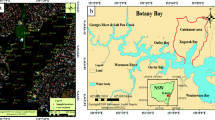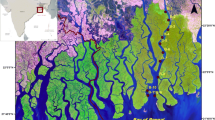Abstract
An evaluation of the concentration of metals in terrestrial and aquatic environments near Artigas Antarctic Scientific Base was assessed. Granulometric characteristics, total organic matter content, concentration of metals (Cd, Cr, Cu, Mn, Ni, Pb and Zn) and metalloid (As) in soil, marine and freshwater sediments were determined. The geoaccumulation index (Igeo) was used in order to analyse the contamination magnitude. Samples were collected in summer 2015–2016 covering 31 sampling stations; 15 terrestrial/soil stations (T0–T14) were placed considering the distribution of Artigas Base buildings and the septic tanks’ location. Eleven freshwater stations were placed along the three meltwater streams near Artigas Base (S0–S10), and two in Uruguay Lake (L1 and L2). Finally, three marine stations in Maxwell Bay were placed one near the Artigas Base (AB) and two far from it in North Cove (NC1, NC2). Some of the terrestrial stations (T2, T10, T11 and T13) presented the highest concentration of metals and Igeo values, which was associated to anthropic activities. Highest metal levels were related to fuel storage and handling, but also, with sewage release and the presence of old leaded paint residues. These polluted sites were limited to a restricted area of Artigas Base, not affecting surrounding environments. Concentrations of the analysed metals in unpolluted sites had the same order of magnitude recorded in other unpolluted areas of the Fildes Peninsula and other Antarctic regions.



Similar content being viewed by others
References
Abakumov, E., Lupachev, A., & Andreev, M. (2017). Trace element content in soils of the King George and Elephant islands, maritime Antarctica. Chemistry and Ecology. https://doi.org/10.1080/02757540.2017.1384821.
Alfonso, J. A., Vasquez, Y., Hernandez, A. C., Mora, A., Handt, H., & Sira, E. (2015). Geochemistry of recent lacustrine sediments from Fildes Peninsula, King George Island, maritime Antarctica. Antarctic Science, 27, 1–10.
Alkarkhi, A. F. M., Ismail, N., Ahmed, A., & Mat Easa, A. (2009). Analysis of heavy metal concentrations in sediments of selected estuaries of Malaysia—a statistical assessment. Environmental Monitoring and Assessment, 153, 179–185.
Amaro, E., Padeiro, A., Mão de Ferro, A., Mota, A. M., Leppe, M., Verkulich, S., Hughes, K. A., Hans-Ulrich, P., & Canário, J. (2015). Assessing trace element contamination in Fildes Peninsula (King George Island) and Ardley Island, Antarctic. Marine Pollution Bulletin, 97, 523–527.
Bargagli, R. (2008). Environmental contamination in Antarctic ecosystems. Science of the Total Environment, 400, 212–226.
Birch, G.F. (2011). Indicators of anthropogenic change and biological risk in coastal aquatic environments. In: Wolanski E, McLusky DS. Treatise on estuarine and coastal science. Ed. Waltham: Academic Press. Publisher: Elsevier, 235–270.
Birch, G. F. (2017). Determination of sediment metal background concentrations and enrichment in marine environments—a critical review. Science of the Total Environment, 580, 813–831.
Braun, C., Mustafa, O., Nordt, A., Pfeiffer, S., & Peter, H.-U. (2012). Environmental monitoring and management proposals for the fildes region (King George Island, Antarctica). Polar Research, 31, 18206. https://doi.org/10.3402/polar.v31i0.18206.
Braun, C., Hertel, F., Mustafa, O., Nordt, A., Pfeiffer, S. & Peter, H-U. (2014). Environmental assessment and management challenges of the Fildes Peninsula Region. Tin et al., (eds.), Antarctic futures, Springer Media Dordrecht, 169–191.
Byers, S. C., Mills, E. L., & Sewart, P. L. (1978). A comparison of methods to determining organic carbon in marine sediments, with suggestion for a standard method. Hydrobiology, 58, 37–43.
Cowan, D. A., Chown, S. L., Convey, P., Tuffin, M., Hughes, K. A., & Pointing, S. (2011). Non-indigenous microorganisms in the Antarctic: assessing the risks. Trends in Microbiology, 19, 540–548.
Crocket, A. B. (1998). Background levels of metals in soils, McMurdo station, Antarctica. Environmental Monitoring and Assessment, 50, 289–296.
Cury, J. C., Jurelevicius, D. A., Villela, H. D. M., Jesus, H. E., Peixoto, R. S., Schaefer, C. E. G. R., Bícego, M. C., Seldin, L., & Rosado, A. S. (2014). Microbial diversity and hydrocarbon depletion in low and high diesel-polluted soil samples from Keller Peninsula, South Shetland Islands. Antarctic Science, 27, 263–227.
Du Laing, G. (2011). Redox metal processes and controls in estuaries. In: Wolanski E, McLusky DS. Treatise on estuarine and coastal science. Ed. Waltham: Academic Press. Publisher: Elsevier, 115–141.
Hernández, A. C., Bastias, J., Matus, D., & Mahaney, W. C. (2018). Provenance, transport and diagenesis of sediment in polar areas: a case study in Profound Lake, King George Island, Antarctica. Polar Research, 37, 1–12. https://doi.org/10.1080/17518369.2018.1490619.
Horowitz, A.J. (1985). A primer on trace metal-sediment chemistry. United States Geological Survey Water-Supply paper 2277. 67 pp.
Ianni, C., Magi, E., Soggia, F., Rivaro, P., & Frache, R. (2010). Trace metal speciation in coastal and off-shore sediments from Ross Sea (Antarctica). Microchemical Journal, 96, 203–212.
Krzyszowska, A. (1993). Human impact around polar stations on Fildes Peninsula (King George Island, Antarctica). XX Polar Symposium, Lublin. 203–208.
López-Martínez, J., Schmid, T., Serrano, E., Mink, S., Nieto, A., & Guillaso, S. (2016). Geomorphology and surface landforms distribution in selected ice-free areas in the South Shetland Islands, northern Antarctic peninsula region. Cuadernos de Investigación Geográfica, 42, 435–455.
Lu, Z., Cai, M., Wang, J., Yang, H., & He, J. (2012). Baseline values for metals in soils on Fildes Peninsula, King George Island, Antarctica: the extent of anthropogenic pollution. Environmental Monitoring and Assessment, 184, 7013–7021.
Luoma, S. N., & Rainbow, P. S. (2008). Metal contamination in aquatic environments: science and lateral management. Cambridge: Cambridge University Press 573 pp.
Michel, R. F. M., Schafer, C. E. G. R., López-Martínez, J., Simas, F. N. B., Haus, N. W., Serrano, E., & Bockheim, J. G. (2014). Soils and landforms from Fildes Peninsula and Ardley Island, Maritime Antarctica. Geomorphology, 225, 76–86.
Müller, V. G. (1986). Schadstoffe in Sedimenten - Sedimente als Schadstoffe. Mitteilungen der Österreichischen Geologischen Gesellschaft, 79, 107–126.
Negri, A., Burns, K., Boyle, S., Brinkman, D., & Webster, N. (2006). Contamination in sediments, bivalves and sponges of McMurdo Sound, Antarctica. Environmental Pollution, 143, 456–467.
Padeiro, A., Amaro, E., Dos Santos, M. M., Araújo, M. F., Gomes, S. S., Leppe, M., Verkulich, S., Hughes, K. A., Peter, H. U., & Canário, J. (2016). Trace element contamination and availability in the Fildes Peninsula, King George Island, Antarctica. Environmental Science Processes & Impacts, 18, 648–657.
Peter, H-U, Braun, C., Mustafa, O. & Pfeiffer, S. (2008). Risk assessment for the Fildes Peninsula and Ardley Island, and development of management plans for their designation as Specially Protected or Specially Managed Areas. German Federal Environment Agency, Dessau, 508 pp.
Ribeiro, A. P., Figueira, R. C. L., Martins, C. C., Silva, C. R. A., Franca, E. J., Bícego, M. C., Mahiques, M. M., & Montone, R. C. (2011). Arsenic and trace metal contents in sediment profiles from the Admiralty Bay, King George Island, Antarctica. Marine Pollution Bulletin, 62, 192–196.
Rodríguez, C., Iglesias, K., Bícego, M. C., Taniguchi, S., Sasaki, S. T., Kandratavicius, N., Bueno, C., Brugnoli, E., & Venturini, N. (2018). Hydrocarbons in soil and meltwater stream sediments near Artigas Antarctic Research Station: origin, sources and levels. Antarctic Science, 30, 170–182.
Romaniuk, K., Ciok, A., Decewicz, P., Uhrynowski, W., Budzik, K., Nieckarz, M., Pawlowska, J., Zdanowski, M. K., Bartosik, D., & Dziewit, L. (2018). Insight into heavy metal resistome of soil psychrotolerant bacteria originating from King George Island (Antarctica). Polar Biology, 41, 1319–1333.
Santos, I. R., Silva-Filho, E. V., Schaefer, C. E. G. R., Albuquerque-Filho, M. R., & Campos, L. S. (2005). Heavy metal contamination in coastal sediments and soils near the Brazilian Antarctic Station, King George Island. Marine Pollution Bulletin, 50, 185–194.
SCAR (1959). Tratado Antártico. Conferencia de la Antártida, Washington. 53 pp.
Suguio, K. (1973). Introdução a Sedimentologia. Edgard Blucher, EDUSP, São Paulo. 317 pp.
Szopińska, M., Namiesnik, J., & Polkowska, J. (2016). How important is research on pollution levels in Antarctica? Historical approach, difficulties and current trends. Reviews of Environmental Contamination and Toxicology, 239, 79–156.
Tin, T., Fleming, Z. L., Hughes, K. A., Ainley, D. G., Convey, P., Moreno, C. A., Pfeiffer, S., Scott, J., & Snape, I. (2009). Review impacts of local human activities on the Antarctic environment. Antarctic Science, 21, 3–33.
Tin, T., Lamers, M., Liggett, D., Maher, P. T., & Hughes, K. A. (2014). Setting the scene: human activities, environmental impacts and governance arrangements in Antarctica. In T. Tin, D. Liggett, P. Maher, & M. Lamers (Eds.), Antarctic Futures. Dordrecht: Springer.
Tort, L. F. L., Iglesias, K., Bueno, C., Lizasoain, A., Salvo, M., Cristina, J., Kandratavicius, N., Pérez, L., Figueira, R., Bícego, M. C., Taniguchi, S., Venturini, N., Brugnoli, E., Colina, R., & Victoria, M. (2017). Wastewater contamination in Antarctic melt-water streams evidenced by virological and organic molecular markers. Science of the Total Environment, 609, 225–231.
Trevizani, T. H., Figueira, R. C. L., Ribeiro, A. P., Theophilo, C. Y. S., Majer, A. P., Petti, M. A. V., Corbisier, T. N., & Montone, R. C. (2016). Bioaccumulation of heavy metals in marine organisms and sediments from Admiralty Bay, King George Island, Antarctica. Marine Pollution Bulletin, 106, 366–371.
USEPA. (1996). Method 3050B. Acid digestion of sediments, sludges and soil. Revision 2. December.
Vieira, R., Marotta, H., Rosa, K. K., Jana, R., Simoes, C. L., Souza Junior, E., Ferreira, F., Ramos, J. V. S., Santos, L. R. S., Perroni, M. A., Goncalves, M., Felizardo, J. P. S., Rodrigues, R. I., & Galvao, J. C. M. (2015). Análisis sedimentológico y geomorfológico de áreas lacustres en la Península Fildes, Isla Rey Jorge, Antártica Marítima. Investigaciones Geográficas, (49), 3–30.
Vodopivez, C., Smichowski, P & Marcovecchio, J. (2001). Trace metals monitoring as a tool for characterization of Antarctic ecosystems. In: Environmental contamination in Antarctica. A challenge to analytical chemistry. Ed: S. Caroli, P. Cescon and D.W.H. Walton.
Wentworth, C. K. (1922). A scale of grade and class terms for clastic sediments. The Journal of Geology, 30, 377–392.
Wuana R.A. & Okieimen, F.E. (2011). Review article. Heavy metals in contaminated soils: a review of sources, chemistry, risks and best available strategies for remediation. International Scholarly Research Network ISRN Ecology 20 pp.
Xie, Z., & Sun, L. (2008). A 1,800-year record of arsenic concentration in the penguin dropping sediment, Antarctic. Environmental Geology, 55, 1055–1059.
Acknowledgments
The authors would like to thank CSIC (Comisión Sectorial de Investigación Científica, Universidad de la República) and the Uruguayan Antarctic Institute (IAU) for their support. SNI-ANII (Agencia Nacional de Investigación e Innovación) is acknowledged for its support to N Venturini. Special thanks to the crew ‘Antarkos XXXI’ of Artigas Antarctic Scientific Base for helping during sampling surveys. Also, the Department of Scientific Coordination of the IAU is very much acknowledged by the authors for supporting the development of this work. This work is part of the Project IAU-P-DCC-15.
Author information
Authors and Affiliations
Corresponding author
Additional information
Publisher’s Note
Springer Nature remains neutral with regard to jurisdictional claims in published maps and institutional affiliations.
Rights and permissions
About this article
Cite this article
Bueno, C., Kandratavicius, N., Venturini, N. et al. An Evaluation of Trace Metal Concentration in Terrestrial and Aquatic Environments near Artigas Antarctic Scientific Base (King George Island, Maritime Antarctica). Water Air Soil Pollut 229, 398 (2018). https://doi.org/10.1007/s11270-018-4045-1
Received:
Accepted:
Published:
DOI: https://doi.org/10.1007/s11270-018-4045-1




